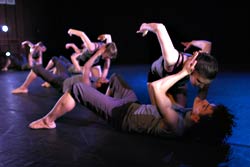For his latest “studio series,” in the intimate Madrona Dance Studio, Spectrum Dance Theater’s artistic director, Donald Byrd, has chosen to bookend his own works with two choreographers who both deal with the limitations and possibilities of ballet.
Zoë Scofield seems to draw her images from the natural world as often as the studio, creating a feral variation of the courtly dance form. The evocative past wanting includes plenty of tricky, technical steps, but they often morph and shift, so that pointed feet flex and willowy arms tense like wings or branches. The deliberate placement of shapes and phrases feels classical, but the material itself twists and stretches outside that tradition. As her dancers stride or waddle straddle-legged across the space, they explore the animal nature of human locomotion. And at the end, when Alison Keppel is lifted with her legs still “walking” forward, she appears as much a long-legged bird as a woman.
The lovely ensemble piece crowded murmur…thoughts, by Olivier Wevers, combines the ease and facility of classical dance with a playful twistiness. The three sections are laced together by an ongoing motif—quieting someone with a hand in front of the mouth and whispering in their ear. Wevers’ movement invention is charming and his skill at manipulating structure and pattern—the traffic cop aspect of choreography—is very assured. He makes the Spectrum performers look every bit as good as they are, and gives the company a delicious valentine of a dance.
Byrd has been reviving some of his older works into the Spectrum repertory, and in this show he’s brought back one of his earliest, a 1976 solo called Partite, and it reads like a little primer on his style—aggressive, complex, challenging, and smart. It’s a kind of face-off between dancer and trumpeter, complete with hints of shadow boxing and attitude. Lara Seefeldt slashes out and twists around while musician Adam Rappa seems more bemused than annoyed. In Quartet, from 1993, we see all that energy distilled and intensified. The essentials of Byrd’s style are still there, while the structure of the movement and the work as a whole have become even more complex. The world he creates is harsh, and the physical manipulation that is the bedrock of partnering reads as a commentary on personal relationships as well as a lesson in physics.
Byrd’s new work on the program, M.I.A., is a mostly lighthearted satire of ballet conventions and behavior. David Alewine is a diva in a grass-skirted tutu, chewing gum and rolling his hips in front of a little corps de ballet. Things get more complex when Lara Seefeldt emerges from the corps to perform straight-ahead technical dancing to the rap score by M.I.A.—the percussive text and beat-box rhythms are an eerie match for her technical brio.
dance@seattleweekly.com








